An Asymmetrical Glycerol Diether Bolalipid with Protonable Phosphodimethylethanolamine Headgroup: The Impact of pH on Aggregation Behavior and Miscibility with DPPC
Abstract
:1. Introduction
2. Materials and Methods
2.1. Syntheses
2.1.1. Preparation of Me2PE-Gly(2C16)C32-OBn
2.1.2. Preparation of Me2PE-Gly(2C16)C32-OH
2.2. Physicochemical Methods
2.2.1. Chemicals
2.2.2. Sample Preparation
2.2.3. Differential Scanning Calorimetry (DSC)
2.2.4. Fourier Transform Infrared (FTIR) Spectroscopy
2.2.5. Transmission Electron Microscopy (TEM)
3. Results and Discussion
3.1. Synthesis of Me2PE-Gly(2C16)C32-OH
3.2. Temperature-Dependent Aggregation Behavior of Me2PE-Gly(2C16)C32-OH
- There is only one Me2PE headgroup present in Me2PE-Gly(2C16)C32-OH compared to two headgroups in Me2PE-C32-Me2PE, whereas the overall size (molar mass) of the asymmetrical Me2PE-Gly(2C16)C32-OH is larger with respect to the symmetrical Me2PE-C32-Me2PE.
- If we assume an interdigitated orientation of the Me2PE-Gly(2C16)C32-OH molecules within the aggregates, as was found for the PC analog [36], the terminal hydroxy group might compensate the negative charge of the deprotonated Me2PE headgroup.
- For the pH-dependent experiments using the symmetrical Me2PE-C32-Me2PE [38], unbuffered suspensions were used and the pH was adjusted with conc. NaOH solution. Here, a carbonate buffer was used. The additional ions present in the solution (sodium and potassium) could partially shield the negative charge of the deprotonated Me2PE headgroup.
3.3. Mixing Behavior of Me2PE-Gly(2C16)C32-OH with DPPC
4. Conclusions
Supplementary Materials
Acknowledgments
Author Contributions
Conflicts of Interest
References
- Fuhrhop, J.-H.; Wang, T. Bolaamphiphiles. Chem. Rev. 2004, 104, 2901–2937. [Google Scholar] [CrossRef] [PubMed]
- Langworthy, T.A. Long-chain diglycerol tetraethers from Thermoplasma acidophilum. Biochim. Biophys. Acta Lipids Lipid Metab. 1977, 487, 37–50. [Google Scholar] [CrossRef]
- De Rosa, M.; Esposito, E.; Gambacorta, A.; Nicolaus, B.; Bu’Lock, J.D. Effects of temperature on ether lipid composition of Caldariella acidophila. Phytochemistry 1980, 19, 827–831. [Google Scholar] [CrossRef]
- Gambacorta, A.; Gliozzi, A.; Rosa, M. Archaeal lipids and their biotechnological applications. World J. Microbiol. Biotechnol. 1995, 11, 115–131. [Google Scholar] [CrossRef] [PubMed]
- Woese, C.R.; Magrum, L.J.; Fox, G.E. Archaebacteria. J. Mol. Evol. 1978, 11, 245–252. [Google Scholar] [CrossRef] [PubMed]
- Koch, R.; Zablowski, P.; Spreinat, A.; Antranikian, G. Extremely thermostable amylolytic enzyme from the archaebacterium Pyrococcus furiosus. FEMS Microbiol. Lett. 1990, 71, 21–26. [Google Scholar] [CrossRef]
- Baumeister, W.; Lembcke, G. Structural features of archaebacterial cell envelopes. J. Bioenergy Biomembr. 1992, 24, 567–575. [Google Scholar] [CrossRef]
- Cornell, B.A.; Braach-Maksvytis, V.B.L.; King, L.G.; Osmann, P.D.J.; Raguse, B.; Wieczorek, L.; Pace, R.J. A biosensor that uses ion-channel switches. Nature 1997, 387, 580–583. [Google Scholar] [CrossRef] [PubMed]
- Bakowsky, U.; Rothe, U.; Antonopoulos, E.; Martini, T.; Henkel, L.; Freisleben, H.J. Monomolecular organization of the main tetraether lipid from Thermoplasma acidophilum at the water-air interface. Chem. Phys. Lipids 2000, 105, 31–42. [Google Scholar] [CrossRef]
- Benvegnu, T.; Réthoré, G.; Brard, M.; Richter, W.; Plusquellec, D. Archaeosomes based on novel synthetic tetraether-type lipids for the development of oral delivery systems. Chem. Commun. 2005, 5536–5538. [Google Scholar] [CrossRef] [PubMed]
- Brown, D.A.; Venegas, B.; Cooke, P.H.; English, V.; Chong, P.L.-G. Bipolar tetraether archaeosomes exhibit unusual stability against autoclaving as studied by dynamic light scattering and electron microscopy. Chem. Phys. Lipids 2009, 159, 95–103. [Google Scholar] [CrossRef] [PubMed]
- Jain, N.; Arntz, Y.; Goldschmidt, V.R.; Duportail, G.; Mély, Y.; Klymchenko, A.S. New unsymmetrical bolaamphiphiles: Synthesis, assembly with DNA, and application for gene delivery. Bioconjug. Chem. 2010, 21, 2110–2118. [Google Scholar] [CrossRef] [PubMed]
- Nuraje, N.; Bai, H.; Su, K. Bolaamphiphilic molecules: Assembly and applications. Prog. Polym. Sci. 2013, 38, 302–343. [Google Scholar] [CrossRef]
- Fuhrhop, J.H.; Liman, U.; Koesling, V. A macrocyclic tetraether bolaamphiphile and an oligoamino α,ω-dicarboxylate combine to form monolayered, porous vesicle membranes, which are reversibly sealed by edta and other bulky anions. J. Am. Chem. Soc. 1988, 110, 6840–6845. [Google Scholar] [CrossRef]
- Moss, R.A.; Li, G.; Li, J.-M. Enhanced dynamic stability of macrocyclic and bolaamphiphilic macrocyclic lipids in liposomes. J. Am. Chem. Soc. 1994, 116, 805–806. [Google Scholar] [CrossRef]
- Brard, M.; Richter, W.; Benvegnu, T.; Plusquellec, D. Synthesis and supramolecular assemblies of bipolar archaeal glycolipid analogues containing a cis-1,3-disubstituted cyclopentane ring. J. Am. Chem. Soc. 2004, 126, 10003–10012. [Google Scholar] [CrossRef] [PubMed]
- Jacquemet, A.; Barbeau, J.; Lemiègre, L.; Benvegnu, T. Archaeal tetraether bipolar lipids: Structures, functions and applications. Biochimie 2009, 91, 711–717. [Google Scholar] [CrossRef] [PubMed]
- Mahmoud, G.; Jedelska, J.; Strehlow, B.; Bakowsky, U. Bipolar tetraether lipids derived from thermoacidophilic archaeon Sulfolobus acidocaldarius for membrane stabilization of chlorin e6 based liposomes for photodynamic therapy. Eur. J. Pharm. Biopharm. 2015, 95, 88–98. [Google Scholar] [CrossRef] [PubMed]
- Uhl, P.; Helm, F.; Hofhaus, G.; Brings, S.; Kaufman, C.; Leotta, K.; Urban, S.; Haberkorn, U.; Mier, W.; Fricker, G. A liposomal formulation for the oral application of the investigational hepatitis B drug myrcludex B. Eur. J. Pharm. Biopharm. 2016, 103, 159–166. [Google Scholar] [CrossRef] [PubMed]
- Leriche, G.; Cifelli, J.L.; Sibucao, K.C.; Patterson, J.P.; Koyanagi, T.; Gianneschi, N.C.; Yang, J. Characterization of drug encapsulation and retention in archaea-inspired tetraether liposomes. Org. Biomol. Chem. 2017, 15, 2157–2162. [Google Scholar] [CrossRef] [PubMed]
- Paolucci, V.; Leriche, G.; Koyanagi, T.; Yang, J. Evaluation of tetraether lipid-based liposomal carriers for encapsulation and retention of nucleoside-based drugs. Bioorg. Med. Chem. Lett. 2017, 27, 4319–4322. [Google Scholar] [CrossRef] [PubMed]
- Eguchi, T.; Ibaragi, K.; Kakinuma, K. Total synthesis of archaeal 72-membered macrocyclic tetraether lipids. J. Org. Chem. 1998, 63, 2689–2698. [Google Scholar] [CrossRef] [PubMed]
- Arakawa, K.; Eguchi, T.; Kakinuma, K. An olefin metathesis approach to 36- and 72-membered archaeal macrocyclic membrane lipids. J. Org. Chem. 1998, 63, 4741–4745. [Google Scholar] [CrossRef]
- Eguchi, T.; Kano, H.; Arakawa, K.; Kakinuma, K. Synthetic studies of archaeal macrocyclic tetraether lipids: Practical synthesis of 72-membered tetraether model compounds. Bull. Chem. Soc. Jpn. 1997, 70, 2545–2554. [Google Scholar] [CrossRef]
- Eguchi, T.; Arakawa, K.; Terachi, T.; Kakinuma, K. Total synthesis of archaeal 36-membered macrocyclic diether lipid. J. Org. Chem. 1997, 62, 1924–1933. [Google Scholar] [CrossRef] [PubMed]
- Benvegnu, T.; Brard, M.; Plusquellec, D. Archaeabacteria bipolar lipid analogues: Structure, synthesis and lyotropic properties. Curr. Opin. Colloid Interface Sci. 2004, 8, 469–479. [Google Scholar] [CrossRef]
- Brard, M.; Lainé, C.; Réthoré, G.; Laurent, I.; Neveu, C.; Lemiègre, L.; Benvegnu, T. Synthesis of archaeal bipolar lipid analogues: A way to versatile drug/gene delivery systems. J. Org. Chem. 2007, 72, 8267–8279. [Google Scholar] [CrossRef] [PubMed]
- Meister, A.; Blume, A. Self-assembly of bipolar amphiphiles. Curr. Opin. Colloid Interface Sci. 2007, 12, 138–147. [Google Scholar] [CrossRef]
- Jacquemet, A.; Lemiègre, L.; Lambert, O.; Benvegnu, T. How the stereochemistry of a central cyclopentyl ring influences the self-assembling properties of archaeal lipid analogues: Synthesis and cryotem observations. J. Org. Chem. 2011, 76, 9738–9747. [Google Scholar] [CrossRef] [PubMed]
- Markowski, T.; Drescher, S.; Meister, A.; Hause, G.; Blume, A.; Dobner, B. Synthesis of optically pure diglycerol tetraether model lipids with non-natural branching pattern. Eur. J. Org. Chem. 2011, 5894–5904. [Google Scholar] [CrossRef]
- Markowski, T.; Drescher, S.; Meister, A.; Blume, A.; Dobner, B. Structure-property relationships in a series of diglycerol tetraether model lipids and their lyotropic assemblies: The effect of branching topology and chirality. Org. Biomol. Chem. 2014, 12, 3649–3662. [Google Scholar] [CrossRef] [PubMed]
- Köhler, K.; Förster, G.; Hauser, A.; Dobner, B.; Heiser, U.F.; Ziethe, F.; Richter, W.; Steiniger, F.; Drechsler, M.; Stettin, H.; et al. Temperature-dependent behavior of a symmetric long-chain bolaamphiphile with phosphocholine headgroups in water: From hydrogel to nanoparticles. J. Am. Chem. Soc. 2004, 126, 16804–16813. [Google Scholar] [CrossRef] [PubMed]
- Köhler, K.; Förster, G.; Hauser, A.; Dobner, B.; Heiser, U.F.; Ziethe, F.; Richter, W.; Steiniger, F.; Drechsler, M.; Stettin, H.; et al. Self-assembly in a bipolar phosphocholine-water system: The formation of nanofibers and hydrogels. Angew. Chem. Int. Ed. 2004, 43, 245–247. [Google Scholar] [CrossRef] [PubMed]
- Meister, A.; Drescher, S.; Mey, I.; Wahab, M.; Graf, G.; Garamus, V.M.; Hause, G.; Mögel, H.-J.; Janshoff, A.; Dobner, B.; et al. Helical nanofibers of self-assembled bipolar phospholipids as template for gold nanoparticles. J. Phys. Chem. B 2008, 112, 4506–4511. [Google Scholar] [CrossRef] [PubMed]
- Wahab, M.; Schiller, P.; Schmidt, R.; Moegel, H.J. Monte carlo study of the self-assembly of achiral bolaform amphiphiles into helical nanofibers. Langmuir 2010, 26, 2979–2982. [Google Scholar] [CrossRef] [PubMed]
- Markowski, T.; Drescher, S.; Förster, G.; Lechner, B.D.; Meister, A.; Blume, A.; Dobner, B. Highly asymmetrical glycerol diether bolalipids: Synthesis and temperature-dependent aggregation behavior. Langmuir 2015, 31, 10683–10692. [Google Scholar] [CrossRef] [PubMed]
- Köhler, K.; Meister, A.; Förster, G.; Dobner, B.; Drescher, S.; Ziethe, F.; Richter, W.; Steiniger, F.; Drechsler, M.; Hause, G.; et al. Conformational and thermal behavior of a pH-sensitive bolaform hydrogelator. Soft Matter 2006, 2, 77–86. [Google Scholar] [CrossRef]
- Graf, G.; Drescher, S.; Meister, A.; Dobner, B.; Blume, A. Self-assembled bolaamphiphile fibers have intermediate properties between crystalline nanofibers and wormlike micelles: Formation of viscoelastic hydrogels switchable by changes in pH and salinity. J. Phys. Chem. B 2011, 115, 10478–10487. [Google Scholar] [CrossRef] [PubMed]
- Graf, G.; Drescher, S.; Meister, A.; Garamus, V.M.; Dobner, B.; Blume, A. Tuning the aggregation behaviour of single-chain bolaamphiphiles in aqueous suspension by changes in headgroup asymmetry. Soft Matter 2013, 9, 9562–9571. [Google Scholar] [CrossRef] [PubMed]
- Meister, A.; Köhler, K.; Drescher, S.; Dobner, B.; Karlsson, G.; Edwards, K.; Hause, G.; Blume, A. Mixing behaviour of a symmetrical single-chain bolaamphiphile with phospholipids. Soft Matter 2007, 3, 1025–1031. [Google Scholar] [CrossRef]
- Hirt, G.; Berchtold, R. Synthesis of phosphatides. A new synthesis of lecithin. Pharm. Acta Helv. 1958, 33, 349–356. [Google Scholar] [PubMed]
- Eibl, H.; Nicksch, A. 1,3-Propanedeol Phosphatides. Ger. Offen. DE 2345057 A1 19750327, 27 March 1975. [Google Scholar]
- Drescher, S.; Meister, A.; Blume, A.; Karlsson, G.; Almgren, M.; Dobner, B. General synthesis and aggregation behaviour of a series of single-chain 1,ω-bis(phosphocholines). Chem. Eur. J. 2007, 13, 5300–5307. [Google Scholar] [CrossRef] [PubMed]
- Drescher, S.; Meister, A.; Garamus, V.M.; Hause, G.; Garvey, C.J.; Dobner, B.; Blume, A. Influence of the substitution pattern of phenylene-modified bolaamphiphiles on the aggregations behavior and the miscibility with conventional phospholipids. Eur. J. Lipid Sci. Technol. 2014, 116, 1205–1216. [Google Scholar] [CrossRef]
- Drescher, S.; Garamus, V.M.; Garvey, C.J.; Meister, A.; Blume, A. Aggregation behaviour of a single-chain, phenylene-modified bolalipid and its miscibility with classical phospholipids. Beilstein J. Org. Chem. 2017, 13, 995–1007. [Google Scholar] [CrossRef] [PubMed]
- Blume, A. Applications of Calorimetry to Lipid Model Membranes; Plenum Press: New York, NY, USA, 1988; pp. 71–121. [Google Scholar]
- Meister, A.; Bastrop, M.; Koschoreck, S.; Garamus, V.M.; Sinemus, T.; Hempel, G.; Drescher, S.; Dobner, B.; Richtering, W.; Huber, K.; et al. Structure-property relationship in stimulus-responsive bolaamphiphile hydrogels. Langmuir 2007, 23, 7715–7723. [Google Scholar] [CrossRef] [PubMed]
- Mantsch, H.H.; McElhaney, R.N. Phospholipid phase-transitions in model and biological-membranes as studied by infrared-spectroscopy. Chem. Phys. Lipids 1991, 57, 213–226. [Google Scholar] [CrossRef]
- Mendelsohn, R.; Moore, D.J. Vibrational spectroscopic studies of lipid domains in biomembranes and model systems. Chem. Phys. Lipids 1998, 96, 141–157. [Google Scholar] [CrossRef]
- Snyder, R.G.; Liang, G.L.; Strauss, H.L.; Mendelsohn, R. IR spectroscopic study of the structure and phase behavior of long-chain diacylphosphatidylcholines in the gel state. Biophys. J. 1996, 71, 3186–3198. [Google Scholar] [CrossRef]
- Drescher, S.; Lechner, B.-D.; Garamus, V.M.; Almásy, L.; Meister, A.; Blume, A. The headgroup (a)symmetry strongly determines the aggregation behavior of single-chain phenylene-modified bolalipids and their miscibility with classical phospholipids. Langmuir 2014, 30, 9273–9284. [Google Scholar] [CrossRef] [PubMed] [Green Version]
- Blume, A.; Drescher, S.; Graf, G.; Köhler, K.; Meister, A. Self-assembly of different single-chain bolaphospholipids and their miscibility with phospholipids or classical amphiphiles. Adv. Colloid Interface Sci. 2014, 208, 264–278. [Google Scholar] [CrossRef] [PubMed]
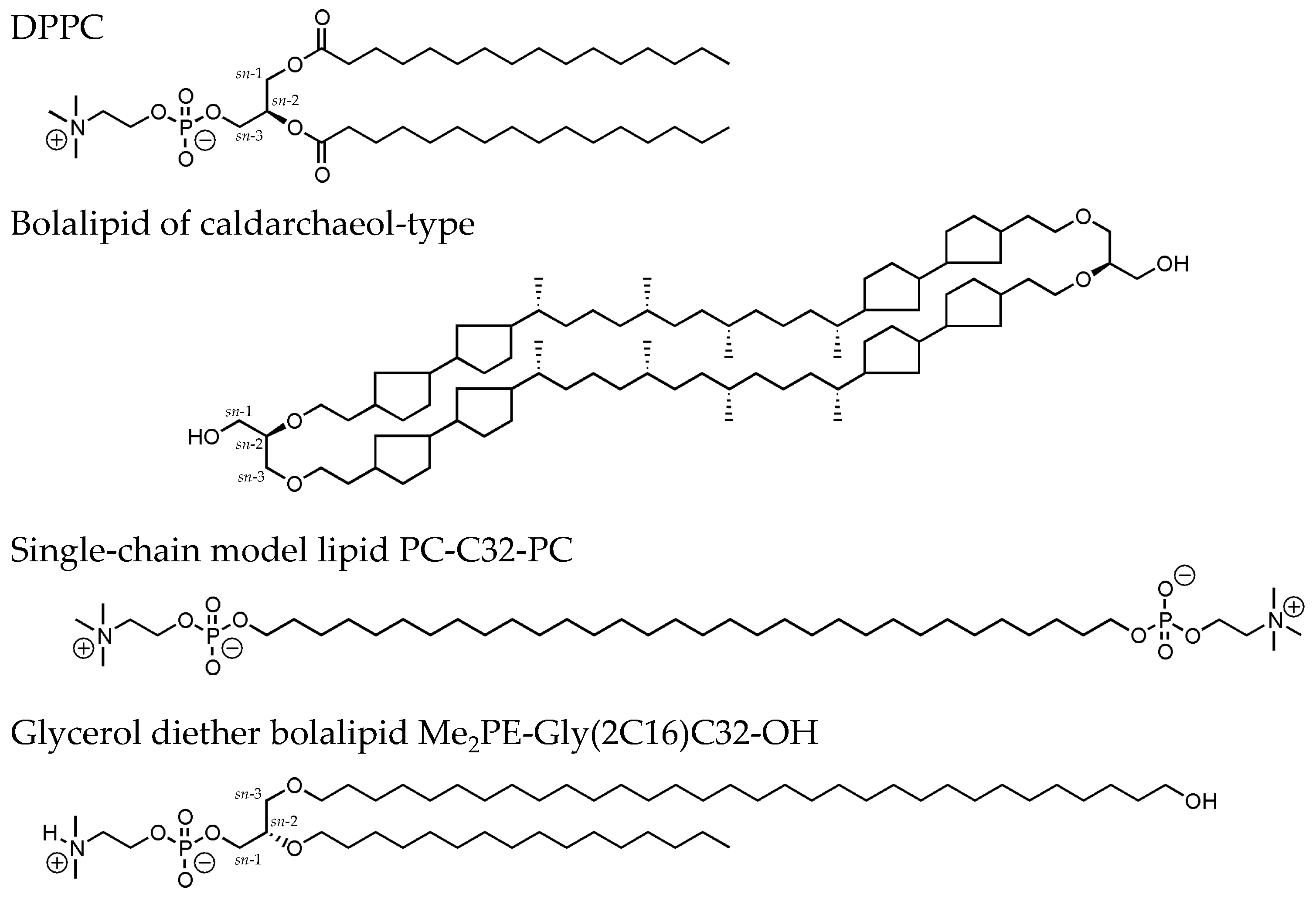
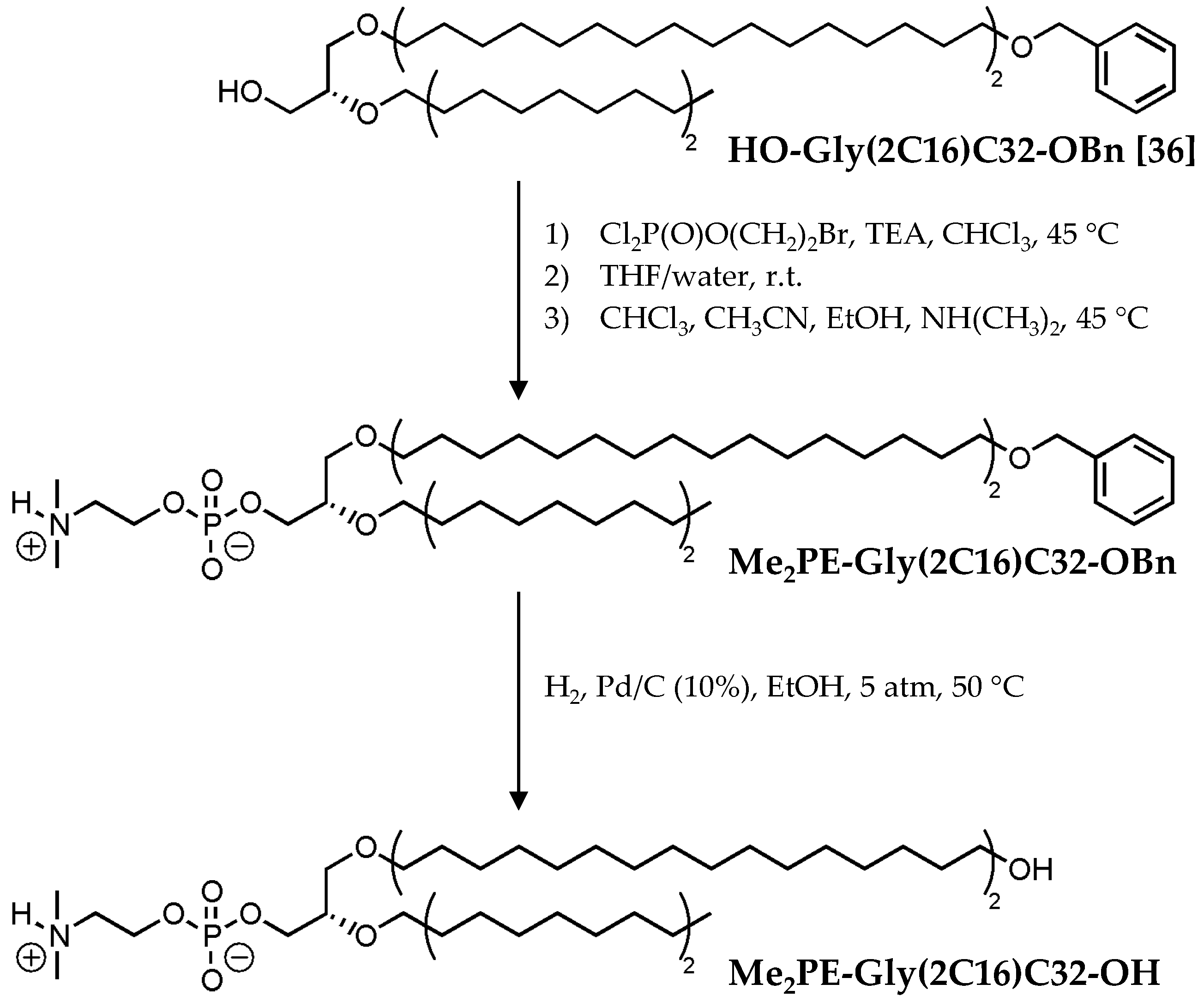

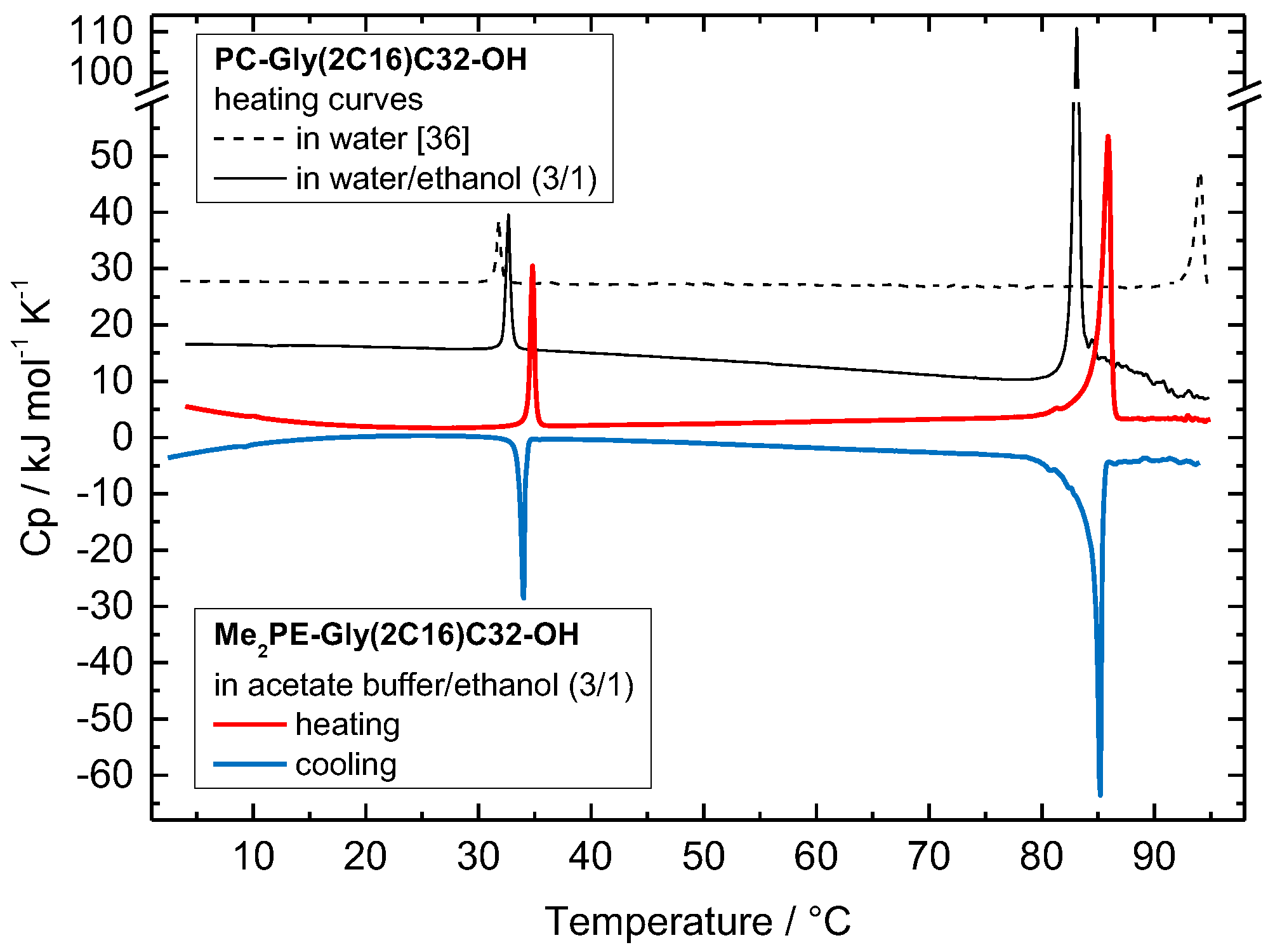
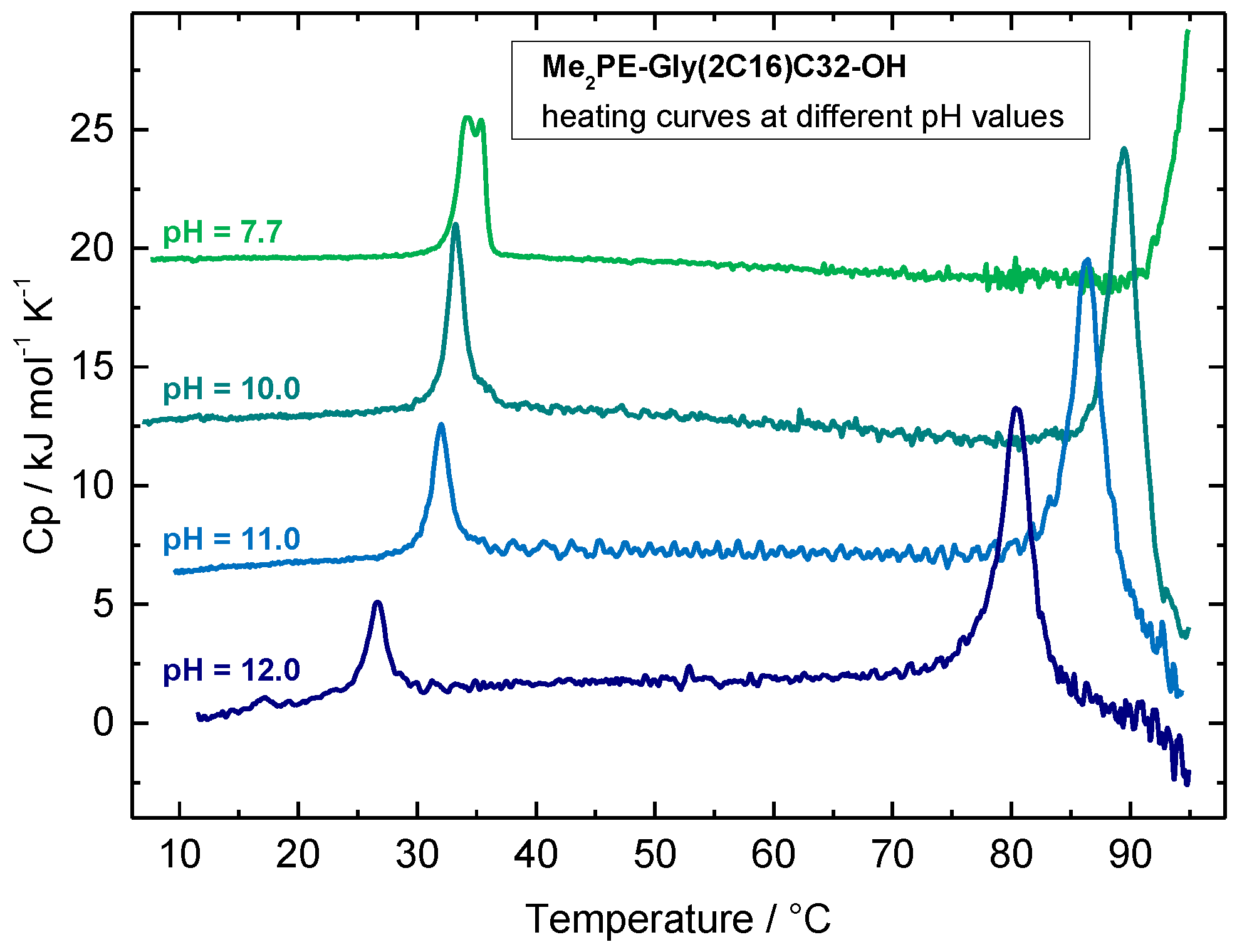
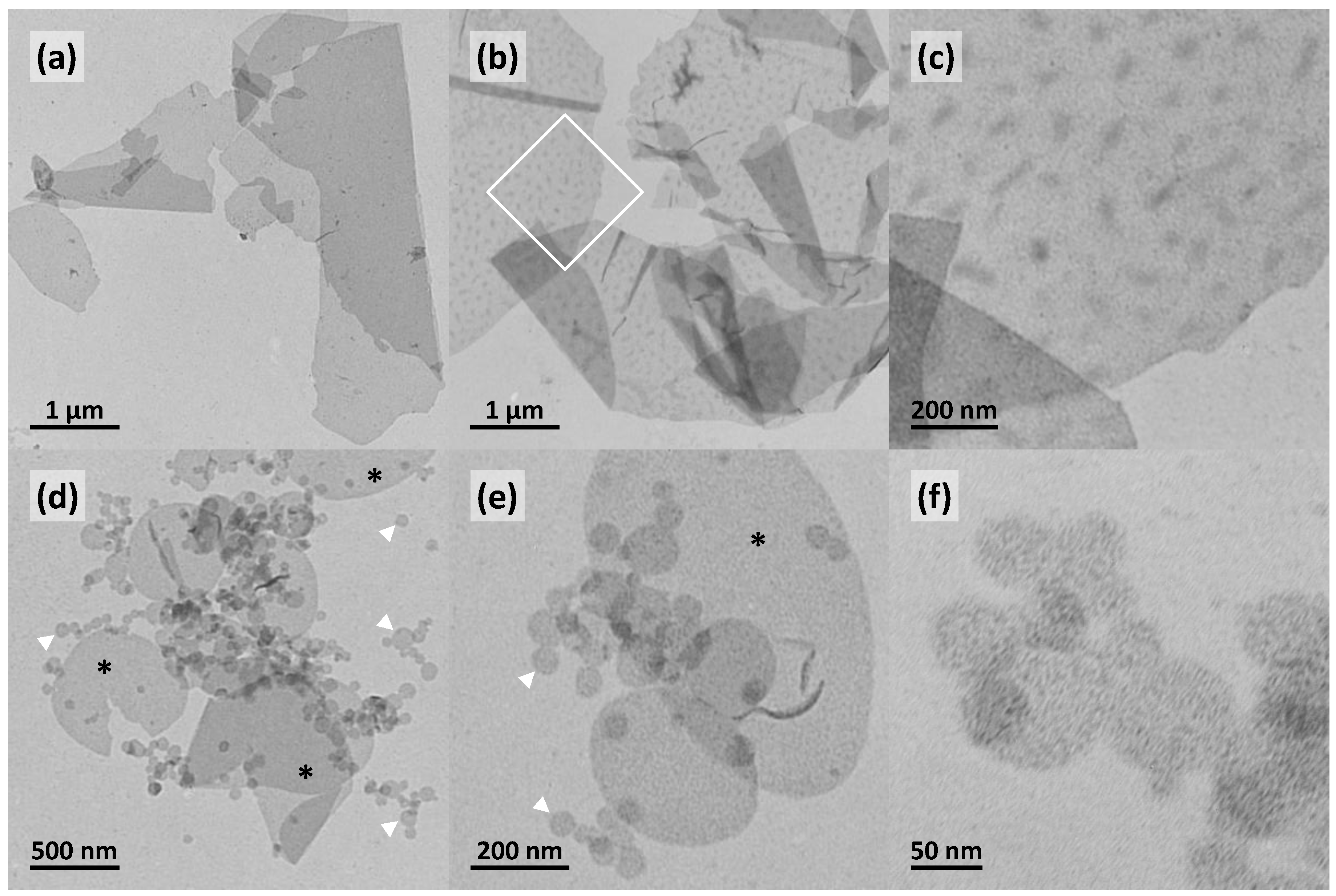
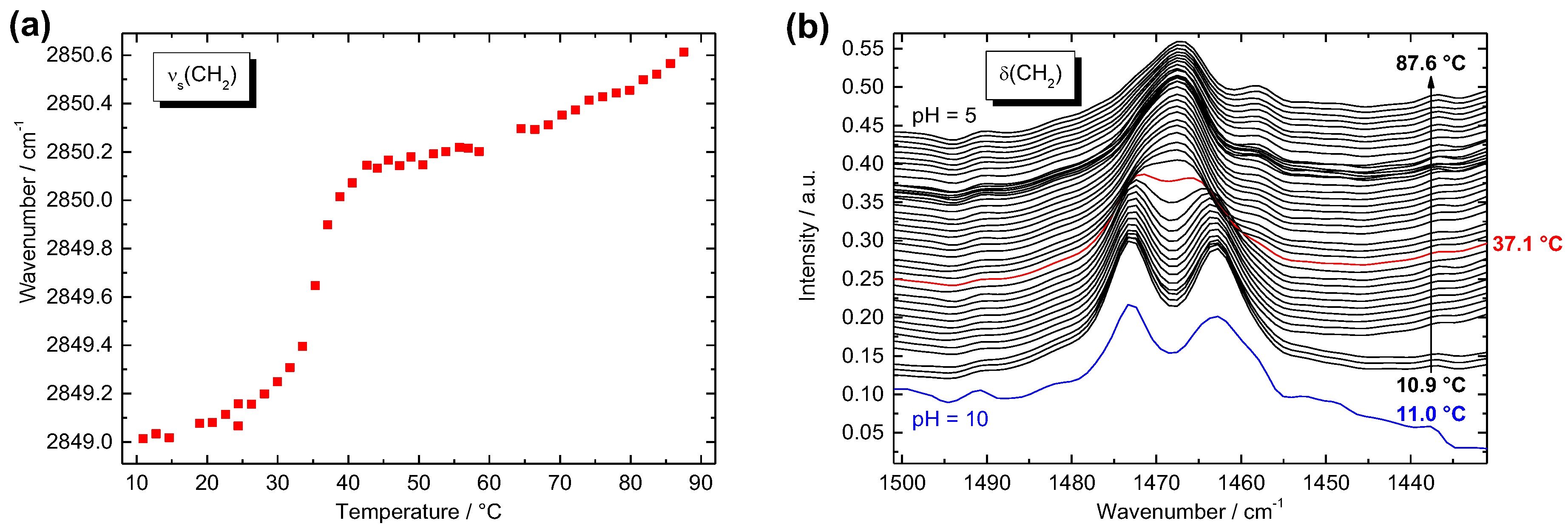
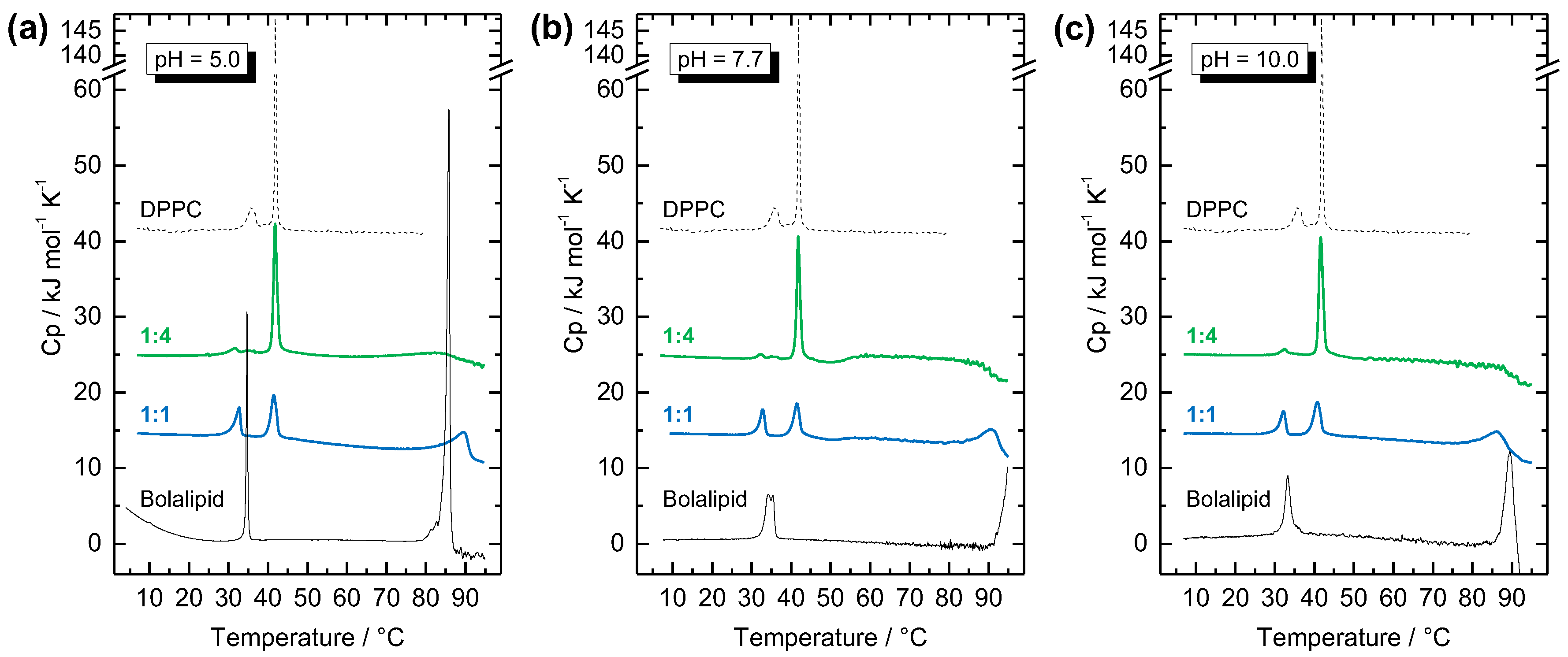

| pH value | Buffer system | First transition (T1) | Second transition (T2) | ||||
|---|---|---|---|---|---|---|---|
| T/°C | Fwhm/K | ΔH/kJ mol−1 | T/°C | Fwhm/K | ΔH/kJ mol−1 | ||
| 5.0 | acetate buffer/ethanol (3/1, v/v) | 34.8 | 0.4 | 13.3 | 85.9 | 0.9 | 60.2 |
| 7.7 | phosphate buffer | 34.2/35.4 | 2.4 | 15.2 | 91 1 | n.a. | n.a. |
| 10.0 | carbonate buffer | 33.2 | 1.5 | 15.8 | 89.5 | 3.0 | 52.8 |
| 11.0 | carbonate buffer + NaOH | 32.0 | 1.7 | 11.0 | 86.4 | 2.8 | 44.1 |
| 12.0 | carbonate buffer + NaOH | 26.6 | 1.8 | 8.9 | 80.4 | 2.7 | 37.2 |
| pH value | Ratio bola:DPPC (n/n) | First transition (T1) | Second transition (T2) | Third transition (T3) | ||||||
|---|---|---|---|---|---|---|---|---|---|---|
| T/°C | Fwhm/K | ΔH/kJ mol−1 | T/°C | Fwhm/K | ΔH/kJ mol−1 | T/°C | Fwhm/K | ΔH/kJ mol−1 | ||
| 5.0 | 1:4 | 31.6 | 1.8 | 1.0 | 41.8 | 1.0 | 20.5 | 85 1 | n.a. | n.a. |
| 1:1 | 32.7 | 1.6 | 8.0 | 41.5 | 1.7 | 11.3 | 89.5 | 5.3 | 21.5 | |
| 7.7 | 1:4 | 32.2 | 1.8 | 1.5 | 41.8 | 1.0 | 19.3 | 2 | n.a. | n.a. |
| 1:1 | 32.8 | 1.5 | 6.3 | 41.5 | 1.8 | 9.4 | 90.5 | 4.8 | 13.0 | |
| 10.0 | 1:4 | 32.5 | 1.7 | 1.6 | 41.6 | 1.2 | 22.3 | 2 | n.a. | n.a. |
| 1:1 | 32.2 | 1.6 | 6.2 | 40.8 | 2.1 | 10.8 | 86.2 | 6.7 | 23.0 | |
© 2017 by the authors. Licensee MDPI, Basel, Switzerland. This article is an open access article distributed under the terms and conditions of the Creative Commons Attribution (CC BY) license (http://creativecommons.org/licenses/by/4.0/).
Share and Cite
Markowski, T.; Müller, S.; Dobner, B.; Meister, A.; Blume, A.; Drescher, S. An Asymmetrical Glycerol Diether Bolalipid with Protonable Phosphodimethylethanolamine Headgroup: The Impact of pH on Aggregation Behavior and Miscibility with DPPC. Polymers 2017, 9, 573. https://doi.org/10.3390/polym9110573
Markowski T, Müller S, Dobner B, Meister A, Blume A, Drescher S. An Asymmetrical Glycerol Diether Bolalipid with Protonable Phosphodimethylethanolamine Headgroup: The Impact of pH on Aggregation Behavior and Miscibility with DPPC. Polymers. 2017; 9(11):573. https://doi.org/10.3390/polym9110573
Chicago/Turabian StyleMarkowski, Thomas, Sindy Müller, Bodo Dobner, Annette Meister, Alfred Blume, and Simon Drescher. 2017. "An Asymmetrical Glycerol Diether Bolalipid with Protonable Phosphodimethylethanolamine Headgroup: The Impact of pH on Aggregation Behavior and Miscibility with DPPC" Polymers 9, no. 11: 573. https://doi.org/10.3390/polym9110573





